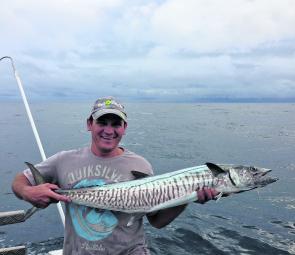We have enjoyed a long run of summer season pelagics along the Sunshine Coast, with mackerel dominating the fishing scene. The season started early, with a strong run of spotties leading as it does into the arrival of Spanish around the 8-10kg mark. As the season goes on, we’ll get a run of larger Spaniards, and some of these hit the 20kg mark. While all this is going happening, we can target wahoo, mahimahi, cobia and a vast range of reef species, making the Sunshine Coast a great place to live and fish.
The bigger female Spanish will stay around for another month or so, as anglers begin to focus on the pending winter season. Pearl perch and squire are certainly being taken on the inner reef systems at the moment, and larger specimens are out on the deeper areas like the Barwon Banks.
The 40m line is the most active, but quality fish can still be taken around the 80m plus dropoffs. Large schools of feeding pelagics always keep anglers entertained, and if you are spending your day working the bait schools, then you will always have success in one form or another. Bait schools have been concentrating around the Gneerings and Murphys, which means you don’t have to go out too far to get amongst them. If the birds are not working, then it may mean a change in tactics to get the bite going.
If you are planning on working a small area, it can’t hurt to begin dropping big cubes of pilchards or any other old bait as you troll around the mark. Eventually it will start the fish feeding process, but be prepared to work hard, as it may take a few hours to get going. The biggest mistake fishermen make is working for an hour or so and moving to another spot to start the process again. Patience is the key!
It is also a great idea to mix up the rigs and lures you are using to get an idea of what is working on the day. For instance, try using a mixture of baits, both live and dead, or shallow and deep diving lures and troll at different speeds. All these variables can put the odds in your favour.
The channel markers and wave buoys can hold cobia and mahimahi. We normally make a point of going past them on the way home in the hope of a last bit of fun. We start by casting small chrome slugs in the immediate area, and if there is no action then we try live or dead bait. If all else fails, we troll past the marker. It helps to have a plan before setting out for the day and to trust in your plan.
The estuaries have been very quiet of late and with the water temperature above 25 degrees, it’s no wonder the fish are looking for deeper holes. The best option is to fish in the early parts of the morning and later into the evenings when everything is quiet and cooler. Live baits are without doubt the best option, so look around for herring, mullet or prawns for best results. The main channel around the Caloundra Bar entrance has opportunities for bigger flathead and trevally, and large herring have been good bait for both species. The boardwalk in Caloundra is busy with hopeful anglers, and a rare few have caught some quality estuary cod and cracker bream on the tide changes.
Whiting are taking small peeled prawns and yabbies at the moment and can be caught right along the Pumicestone Passage, particularly around the Golden Beach strip. Berley is so important to keep the fish interested, and fishing without it can make things really tough. Currimundi Lake has a few smaller bream and the occasional flathead, but overall it is slow. Mangrove jack have been nailing live herring, with the canal areas proving to be the most fruitful. The bream have been holding in under the pontoons around Pelican Waters and throughout the many canals around the Sunshine Coast, so be sure to get your lures or bait right up under them.
The beach scene has been far more productive, with quality bream, whiting and smaller dart working the wave breaks. Pipis, prawns or strips of fish are by far the best baits to use to catch the bread-and-butter varieties. Take your time and watch areas closely throughout tidal changes to identify the best fishing grounds for later.
So for this month organise your trips around the cooler parts of the day. Watch for key signs of fish activity to help improve your chances. The pelagics will remain around and you should look at targeting bigger Spanish mackerel right throughout March. Mahimahi and wahoo will be worth targeting out wide at Caloundra and the Barwon Banks, but you might struggle in closer. Work the reefs on the evening tidal changes and always look around the channel markers and buoys for a cobia or mahimahi.
Check out the estuaries and beaches this month for the table varieties, and fish the deeper channel areas in the early mornings and late into the evenings for best results.
McKe0315_1
Spanish mackerel are just about everywhere at the moment.
McKe0315_2
It’s been a top mackerel season on the Sunshine Coast, with more to come.
Reads: 865





